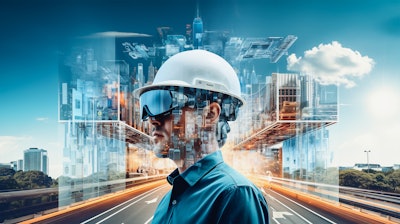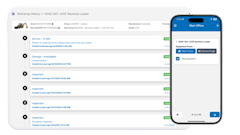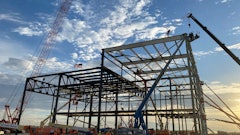
In an industry driven by tight schedules, complex workflows and growing demands for sustainability, building owners and facility managers are turning to artificial intelligence (AI) to bring efficiency and clarity to preconstruction and construction workflows. AI's ability to process large datasets, predict outcomes and automate repetitive tasks can revolutionize project management, offering solutions to some of the most persistent challenges in the built environment.
AI for Smarter Scheduling and Risk Mitigation
One of the most significant challenges in construction is ensuring projects stay on schedule while managing unforeseen risks. AI-driven tools leverage vast datasets to predict potential delays, identify critical risks and suggest proactive actions. By analyzing historical and real-time data from previous projects, AI provides data-backed insights into project timelines, helping managers prioritize tasks and allocate resources efficiently.
For instance, research shows that construction projects typically experience schedule delays that increase costs by an average of 20%. AI can help mitigate these delays by identifying risk patterns and offering actionable solutions. Building owners and facility managers can increase delivery confidence and reduce costs by proactively addressing potential disruptions before they impact the project timeline.
Transforming Cost Estimation with AI
Cost estimation is another labor-intensive yet critical aspect of preconstruction. Traditionally, preparing cost estimates involves weeks or even months of manual calculations, with preconstruction costs averaging $66,000 annually per estimator. AI automates the takeoff process, analyzing design documents and generating accurate estimates in seconds.
AI-powered systems can achieve up to 97% accuracy in cost estimations, significantly reducing errors that often lead to budget overruns. Moreover, AI accelerates the estimation process by 80%, allowing contractors to complete bids faster and submit more competitive proposals. This speed and precision enable facility managers to shift their focus from repetitive data entry to higher-value activities like scoping, value engineering and proposal refinement, ultimately improving profitability and project outcomes.
Enhancing Communication and Data Accessibility
Construction projects generate an overwhelming amount of data, ranging from schedules and blueprints to contracts and meeting notes. Efficiently managing and accessing this information is essential for smooth operations. AI tools tailored for construction can parse, structure and organize these datasets into searchable formats, making critical information accessible in seconds.
For example, a study showed that 35% of construction professionals’ time is spent on non-productive activities like searching for project information or rework. AI streamlines access to project data, reducing these inefficiencies and enabling teams to focus on execution. Real-time communication supported by AI-driven platforms enhances transparency across departments, improving collaboration and minimizing delays caused by miscommunication.
AI for Quality Assurance and Defect Detection
Maintaining quality control during construction is a constant challenge, with rework accounting for up to 10% of project costs. AI-powered inspection tools use image recognition and data analysis to detect defects, such as structural misalignments or material inconsistencies, early in the process.
These tools ensure compliance with building codes and standards while reducing the likelihood of costly rework. For building owners managing complex or multi-site projects, AI offers consistent oversight, helping maintain quality and regulatory compliance without stretching resources.
Increasing Productivity Through Automation
Repetitive tasks like data entry, documentation, and scheduling often consume significant time. AI excels at automating these processes, freeing up professionals to focus on strategic decision-making.
For instance, during preconstruction, AI can analyze site conditions, zoning requirements and market data to generate feasibility reports in minutes. On construction sites, AI-powered robots and drones boost productivity by up to 50%, performing tasks like monitoring worker safety and assessing job progress in real time. These capabilities reduce downtime and improve efficiency, ensuring projects stay on track.
Driving Sustainability and Resilience
AI contributes to sustainability by optimizing resource use and reducing waste. During the preconstruction phase, AI analyzes design models to identify opportunities for using sustainable materials or energy-efficient systems. Predictive analytics can simulate building performance under various conditions, ensuring designs meet resilience goals.
On-site, AI monitors energy use, material consumption, and waste generation in real time, enabling adjustments to align with sustainability targets. A McKinsey report revealed that AI-driven optimizations could cut construction costs by up to 20% and reduce greenhouse gas emissions, aligning projects with broader environmental objectives.
Practical Steps to Leverage AI
For building owners and facility managers, adopting AI-driven tools requires a strategic and phased approach. Here’s how to get started:
- Start Small with Pilot Projects Identify specific pain points, such as scheduling or cost estimation, and implement AI in a controlled pilot project. This approach allows you to test the tool’s impact, refine processes, and build confidence before scaling to more complex workflows.
- Ensure Seamless Integration Choose AI solutions that integrate easily with existing systems like BIM or project management platforms. Compatibility reduces disruptions and enables faster adoption without requiring major reconfigurations.
- Invest in Training Equip teams with the skills to use AI effectively. Provide training to ensure employees can interpret AI outputs and leverage insights for decision-making. Highlight how AI supports, rather than replaces, their expertise, fostering a culture of innovation.
- Partner with Technology Experts Collaborate with experienced providers to customize AI tools for your organization’s needs. Tailored solutions ensure that AI addresses specific challenges, such as optimizing multi-site projects or improving cost accuracy.
- Define Success Metrics Set clear benchmarks, like reduced delays, improved cost accuracy, or increased productivity, to measure the effectiveness of AI tools during pilot phases and broader implementation.
- Scale Gradually Expand AI adoption incrementally, focusing on areas where early benefits were realized. This approach minimizes risks and allows teams to adapt smoothly.
- Stay Informed Keep up with advancements in AI by engaging in industry events and staying connected with experts. Evolving tools can provide new opportunities to enhance workflows and competitiveness.
By following these steps, building owners and facility managers can confidently adopt AI, streamlining workflows, enhancing decisions, and driving better outcomes across projects.
Conclusion
AI-driven tools are reshaping the construction landscape, offering building owners and facility managers unprecedented opportunities to streamline workflows, enhance decision-making, and reduce costs. By leveraging AI for smarter scheduling, accurate cost estimation, efficient communication, and quality control, professionals can transform preconstruction and construction processes, reducing costs and enhancing sustainability.
As the built environment grows more complex, embracing AI will be essential for staying competitive and delivering exceptional results. The technology’s potential to enhance productivity, reduce errors, and meet sustainability goals positions it as a game-changer in the industry.




















